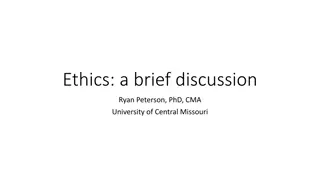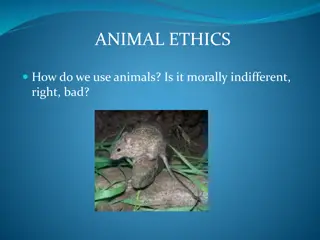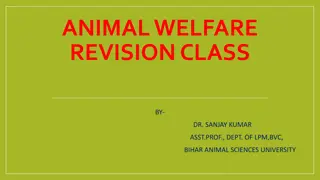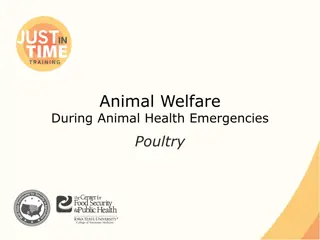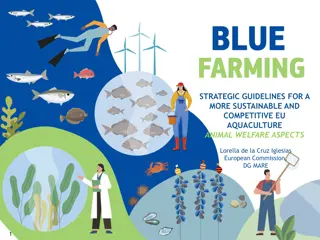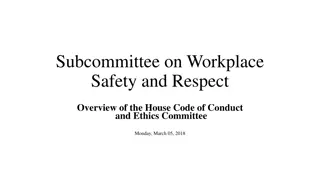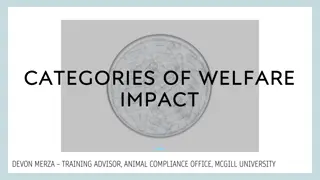Animal Welfare and Ethics: Standards and Regulations in India
The content covers a wide range of topics related to animal welfare, ethics, and laws in India. It delves into the definition of animal welfare, the role of veterinarians, animal welfare organizations, regulations like the Prevention of Cruelty to Animals Act, and protection of wildlife, working animals, and pets. It also discusses the study of animal behavior and the field of ethology.
Download Presentation

Please find below an Image/Link to download the presentation.
The content on the website is provided AS IS for your information and personal use only. It may not be sold, licensed, or shared on other websites without obtaining consent from the author. Download presentation by click this link. If you encounter any issues during the download, it is possible that the publisher has removed the file from their server.
E N D
Presentation Transcript
1. Definition of animal welfare and ethics. Human and animal welfare in relation to ecosystem and environmental factors. Role of veterinarians in animal welfare. Animal welfare organizations, Animal Welfare Board of India - their role, functions and current status. Rules, regulations, laws on animal welfare. Prevention of Cruelty to Animals PCA Act, 1960 {59 of 1960). Legal duties of veterinarians, Common offences against animals and laws related to these offences. Role and function of Committee for the Purpose of Controlling and Supervising Experiments in Animals (CPCSEA). Protection of wild life in nature and captivity. Protection and welfare of performing animals. Welfare of animals during transportation. Animal welfare in commercial livestock farming practices. Protection and welfare of working animals. Pet and companion animal welfare. Animal welfare during natural calamities and disaster management. Provincial and Central Acts relating to animals. Laws relating to offences affecting Public Health. Livestock Importation Act Evidence, liability and insurance. Code of Conduct and Ethics for veterinarians - the Regulations made under Indian Veterinary Council Act, 1984. 2. 3. 4. 5. 6. 7. 8. 9. 10. 11. 12. 13. 14. 15. 16. 17.
Lecture-1 Definition of animal welfare and ethics. Human and animal welfare in relation to ecosystem and environmental factors.
The study of animal welfare is related with the development of science of animal behaviour. Study of animal behaviour- What animal do? In early 17th century the mechanistic view was prevalent Means the body of animals and men act like machines and move according with purely mechanical laws. They are moving through life without consciousness or self awareness. Darwin (1859) through his book origin of species seriously raised doubt about the mechanistic view of animal behaviour. In his book the descent of man he believe animals have sensation and they can think. F.B. Skinner (1958) wrote in his book the behaviour of organism that all behaviour could be explained by principle of stimulus- response and operant conditioning. Operant conditioning uses food rewards and punishment to train animals and shape their behaviours.
Conti... The field of ethology was firmly established in late 1930s with the publication of the first journal related to animal behaviour in Germany. Konard Lorenz (Austria), Van Frish (Austria), and Niko Tinbergen (Netherland) were three zoologist awarded the nobel prize in physiology and medicine in 1973. Lorenz is regarded as father of modern ethology. He discovered the phenomenon of imprinting (formation of permanent close attachment during early post natal period between an animal and salient environmental object such as its mother). Lorenz and Tinbergen developed the ethogram (complete listing of all behaviour that an animal perform in its natural environment). Von frish explained waggle dance behaviour of honey bee which convey direction and distance to sources of pollen by this characteristic dance.
The avoidance of abuse and exploitation of animals by humans through appropriate standards of accommodation, feeding, general care, prevention, treatment of disease, assurance of freedom from harassment, unnecessary discomfort and pain. According to OIE (Office International des Epizooties, the world organization for animal health), - AW means how an animal is coping with the conditions in which it lives. An animals is in good state of welfare (as indicated by scientific evidences) it is healthy, comfortable, well nourished, safe, able to express innate behavior and if it is not suffering from unpleasant states such as pain, fear and distress. Good AW requires disease prevention and veterinary treatment, appropriate shelter, management, nutrition, humane handling and humane slaughter/ killing. AW refers to the state of the animal, the treatment that an animal receives is covered by other terms such as animal care, animal husbandry and humane treatment.
Conti... According to farm animal welfare council 5 freedoms that are required to ensure that animals are in stress free environment are- freedom from Hunger, thirst, and malnutrition Thermal or physical stress Disease or injury Fear To express most normal behavior DIFFERENT PERSPECTIVE AW Welfare science- consider the effect on the animal from the animals point of view. Welfare ethics- consider human action towards animals. Welfare legislation- consider how human must treat animals.
Animal ethics is a term used in academia to describe human-animal relationships and how animals ought to be treated. The subject matter includes animal rights, animal welfare, animal law, speciesism, animal cognition, wildlife conservation, the moral status of nonhuman animals, the concept of nonhuman personhood, human exceptionalism, the history of animal use, and theories of justice. Utilitarianism theory- an ethical theory which emphasises the consequences of action rather than the rules or principle which guide us. Deontological theory-it is duty base ethical system. The word deontological is derived from the greek deontos- meaning obligation.
Animal rights are another form of deontological theory. Moral rights are very strong claims that cannot be overridden merely to produce beneficial consequences. The version of animal rights demand the abolition of any use of animals, including the use of animals for food, clothes, luxury items like fur, experimentation and entertainment.
ANIMAL RIGHTS ANIMAL WELFARE It denotes the philosophical belief that animals should have rights, including the right to live their lives free of human intervention Philosophically opposed the use of animals by humans Denotes the desire to prevent unnessessry animals sufferings Not categorically opposed the use of animals by humans Using animal is morally wrong Morally right We should not use animals to benefit us We can use animals to benefit us We should not invariably overrule the interest of animals with human interest Our interest are always more important than interest of animals We should not inflict pain or death on animals We should not cause unnecessary pain or death We should always treat animals humanely and eliminate the human made causes of animal sufferings We should treat animal as humanely as convenient to us
Ecosystem is a community of living organisms (plants, animals and microbes) in conjunction with the nonliving components of their environment (air, water and mineral soil) interacting as a system. ENVIRONMENTAL FACTORS Environmental factor or ecological factor or ecofactor is any factor, abiotic or biotic, that influences living organisms. Abiotic factors include ambient temperature, amount of sunlight, and pH of the water, soil in which an organism lives. Among the environmental factors temperature is most important factor. environment human animals
Caring and management for animals during extreme heat/hot weather Managing animals in high temperatures requires good forward planning. Keeping an eye on the weather forecasts, and developing a plan for days of high to extreme temperature is essential in ensuring that your animals will have sufficient shade and water on those very hot days. IDENTIFYING HEAT STRESS There are many signs of heat stress that you can look for in your animals. Some general signs include: Panting Increased respiration rate Increased water intake Loss of appetite Listless/lethargy Increased salivation In severe cases may become unconscious.
WATER clean, cool water and shade Water troughs - large enough and designed in such a way that all animals have easy access. The number of watering points and/or water flow should be increased if a large number of animals are kept together. Troughs or containers should be firmly fixed so they cannot overturn. Water pipes should be of sufficient diameter with sufficient pressure to cope with periods of peak demand. SUITABLE SHELTER provided with shelter during extended periods of extreme temperatures. Shelter is especially important for very young or old animals or animals that are in poor condition or sick. Trees with large canopies can be planted individually in fields. Trees have a cooling effect due to absorption of heat by the leaves. Pets and small animals should be moved to cool areas of the house or shed. It is preferable that shelter includes sufficient room for all animals to be able to lie down, as this assists with cooling. It may be necessary to divide the number of animals into smaller groups. Group mentality may mean that even when animals have access to several smaller areas of shelter they will tend to camp together crowding under one source and around water. Holding and processing areas for livestock should have shaded areas available. Use of water sprinklers can be useful to cool some species (i.e. pigs, cattle). HANDLING It is recommended not to handle animals in extreme heat unless absolutely necessary. If necessary, make sure it is done as early or late in the day as possible when temperatures are lower.
Conti... Movement or handling of cattle during hot weather can increase their body temperature by 0.5 to 3.5 C. Increased body temperature or heat stress will cause production losses in livestock and impact on their ability to maintain normal function. Moving animals during cooler hours can decrease the impact of high temperatures on production performance. TRANSPORT Pre-determine your route, mark out a map with places of shade and perhaps water availability (such as rest stops). Animals should only be transported during the cooler hours of the day. If it is necessary to stop, park the vehicle in the shade and at right angles to the wind direction to improve wind flow between animals during hot weather. Duration of stops should be kept to a minimum to avoid the build-up of heat while the vehicle is stationary. Stocking densities should be reduced to 85 % of capacity to ensure good air flow between animals, and drivers should have contingency plans in place for the occurrence of adverse weather events. Heat stress tolerances can also vary between and within a species pigs become heat stressed at a lower temperature level and are very prone to sunburn. Sheep that are newly shorn are at risk of sunburn Lactating cattle are more susceptible than dry cows because of the additional metabolic heat generated during lactation High producing dairy cows are more effected by extreme heat than lower producing cows Beef cattle with black hair suffer more from direct solar radiation than those with lighter hair, although those with pink skin are at risk of sunburn These types of animals should be watched more closely for signs of heat stress during days of high temperature.
Animal Welfare & Management by BHM Patel, SB Prasanna, Mahadevappa D Gouri (Author), New India Publishing Agency (Publisher)













